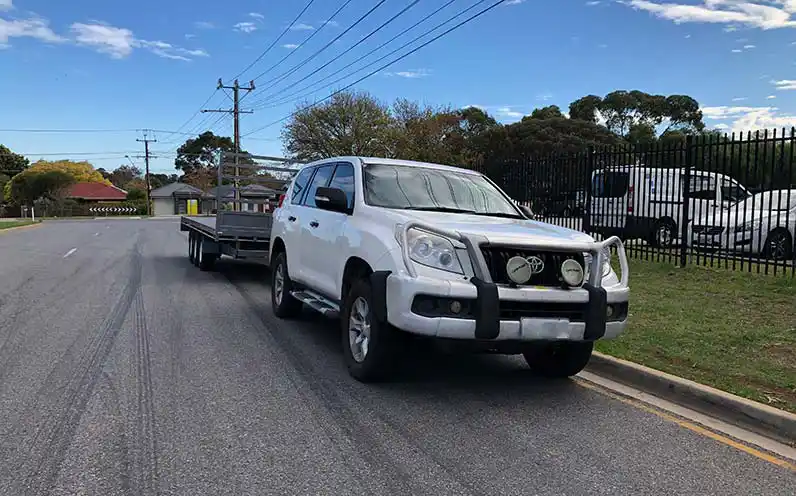Choosing the Right Vehicle for Towing in Australia

If you want to get the most out of any trailer that you buy in Adelaide in terms of its road handling and durability, you also need to make sure that you have the right sort of towing vehicle as well.
Most modern cars on the market today can cope well enough with the smaller trailers in our range, like a 6x4 single axle trailer for instance, but if you plan regularly to tow a larger trailer, like a car trailer or a tipper trailer, for example, then you need to ensure that you have the right sort of vehicle that will be capable of towing it safely.
So what qualities and features should you be looking out for in a towing vehicle in order to tow one of our Adelaide trailers safely, and without putting too many demands on your car or 4WD?
Vehicle and trailer ratings
There are a number of key ratings or measures that you need to be aware of when you are calculating the overall towing abilities of a vehicle:
Kerb weight
This is how much a vehicle weighs when it has a full fuel tank, but without any other load onboard, such as passengers or equipment, and without its accessories e.g., a bull bar.
Gross vehicle mass (GVM)
The GVM of your vehicle will vary, as it combines the kerb weight with anything that is being carried in the vehicle (including passengers), plus any accessories that have been fitted.
Gross combination mass (GCM)
This is the maximum permissible towing weight for the vehicle, and consists of the GVM plus the trailer’s ATM (see below).
Aggregate trailer mass (ATM)
This is the combined weight of the trailer with its full load when not coupled with a tow vehicle, and is the way we measure the carrying capacity of our trailers at Basic Trailers. If you need to carry heavy loads, please note that we have a range of trailer upgrade packages available that increase the overall ATM of all of the trailers in our range.
Gross trailer mass (GTM)
This is the weight that a fully loaded trailer imposes on its axle(s) when it is coupled to a towing vehicle. We generally find it more helpful and practical, however, to use ATM when we rate our trailers.
Towing capacity
All vehicles on the market today have a rated towing capacity determined by the manufacturer, which is the maximum ATM that the vehicle can tow safely. The biggest 4WDs in Australia will be rated to tow a 3,000 kg ATM or 3,500 kg ATM load, and so should be capable of towing even our largest trailers.
However, you also need to ask yourself how often you expect to be towing this size of load, and whether a large 3,500 kg ATM towing capacity is actually necessary to meet your needs, especially if you’re just using your single axle cage trailer on the weekends to move garden or household waste, or perhaps the odd load of furniture.
On the other hand, however, if you’re a tradie, or towing cars or plant regularly, then you certainly need to ensure that any towing vehicle you choose has sufficient towing capacity to match the ATM of your trailer.
Power and torque
When you’re towing a trailer with an ATM of 2,800 kg or above, you not only need pulling power in your towing vehicle, but you also require torque as well.
For towing heavier loads in particular, you should be looking for a 4WD with a peak torque output that is spread across the rev range lower end, as this means it can maintain pulling power without needing to rev the engine too hard. This is especially important when you are starting up from stationery or when you have long hill climbs to negotiate.
On the whole, turbo-diesel engines perform the best in this area, as they produce more torque across a wider rev range, which is ultimately more important when towing a trailer than the torque that is developed at peak power.
Manual or automatic?
On the whole, an automatic will be more fuel efficient and provide a better towing experience than a manual gearbox.
Most of the automatic 4WDs on the market in Australia will have between six and nine different ratios, which helps to maintain maximum power and torque. Also, modern automatic gearboxes make the shift between gears so swiftly that you tend not to lose momentum in the same way that you might when you change gears in a manual, especially important when towing a heavy trailer, or when towing in steep terrain.
A number of SUVs and 4WDs with automatic gearboxes also have driving modes designed specifically for towing, and these can also help to produce better road performance and fuel efficiency.
Wheelbase and track
We would always recommend a vehicle with as long a wheelbase as possible, combined with a wide track, if you are going to be towing heavy loads consistently.
A long wheelbase generally produces a smoother towing experience, especially when accelerating and slowing down, as well as on uneven road surfaces. A wider track also helps in this regard, as it means you experience less roll when turning.
More advice on towing Adelaide trailers
No-one knows more about towing trailers in Adelaide than we do, so if you want some advice on matching the right sort of trailer with your vehicle, don’t hesitate to get in touch. Call Sam at Basic Trailers on 1300 770 770 or email us and we all be happy to advise you as the best sort of trailer and vehicle combination for your needs.
